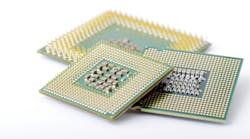Download this article in PDF format.
Semiconductors serve as the basic building blocks for all modern electronics and, as such, their production, availability and distribution are always under a microscope. Without these “chips”—those tiny pieces of silicon made up of transistors—there would be no computers, smartphones, tablets, televisions, cars, industrial equipment or medical devices.
After experiencing massive global shortages during and after the global pandemic, the chip industry appears to be righting itself and preparing for future growth. Much to the relief of the manufacturers that rely on these critical components, availability of most chip types has “loosened up” considerably this year. And while sectors like auto manufacturing continue to grapple with long lead times on some chip types, for the most part the global chip shortage has thankfully faded.
“The world’s largest contract chip manufacturer thinks a turnaround in the semiconductor market is finally near,” WSJ reports. It says Taiwan Semiconductor Manufacturing Co. (TSMC) has “begun to see signs of stabilization in demand for smartphones and personal computers.”
Chip demand for artificial intelligence (AI) applications remains strong, the publication adds, though it’s not yet enough to offset the cyclical swings in chip demand as a whole. “TSMC’s relatively bullish outlook adds to other recent signs—like better outlooks from memory chip makers—that things are improving in the semiconductor industry,” WSJ states.
Boosting U.S. Chip Production
The U.S. share of overall chip manufacturing fell from 37% to 12% over the last three decades, namely because it costs at least 20% more to build and operate a new fab in the U.S. as compared to Asia. Now, Micron is doubling down on U.S. manufacturing, CNBC reports, and has broken ground on an advanced memory production plant that will open in 2026.
Located in Boise, Idaho, the $15 billion chip fabrication plant is situated next to the company’s existing research and development facility. Micron is also planning the biggest chip project in U.S. history, spending $100 billion over 20 years to build four 600,000 square foot fabs in upstate New York, CNBC says. Micron’s goal is to vastly increase the U.S. share of DRAM production, which is currently 2%.
The company is getting assistance from the federal CHIPS and Science Act, which financially incentivizes domestic production. “With Micron’s investments through CHIPS support in [Boise and Syracuse], that 2% over the course of nearly 20 years will be changing to about 15% of the worldwide production coming from the U.S.,” Micron CEO Sanjay Mehrotra told CNBC.
It’s a Buyers’ Market
Buyers of electronic parts are now getting better deals than a few years back. But Supplyframe is warning that beginning next year, buyers may face challenges getting the parts they need. The company says the electronics component market is “expected to remain stable for the rest of 2023, with most prices and lead times declining or staying flat,” Pasadena Now reports.
The report also shows that the electronics supply chain has recovered from the disruptions caused by the pandemic and the trade tensions between the U.S. and China. It also says the recovery is uneven across different industry segments and components, and some risks remain for 2024 and beyond.
“The electronics supply chain will remain a buyers’ market into 2024,” Supplyframe’s Steve Flagg said in a press release. “But given the uneven demand recovery across industry segments and electronics components, continuing macroeconomic volatility, and some raw material price increases, any swift uptick in component demand will threaten the ability of sourcing organizations to calibrate cost negotiation with continuity and assurance of supply.”
Tightening up Export Restrictions
This month, the U.S. Commerce Department introduced its latest export controls update with the goal of limiting U.S. exports of advanced computer chips—and the equipment used to make them—to China.
The revisions were published roughly a year after the export controls were first launched to counter the use of the chips for military applications that include the development of hypersonic missiles and artificial intelligence, AP reports. China called the new controls “improper” and urged Washington to lift them.
U.S. Commerce Secretary Gina Raimondo said the restrictions are meant to protect technologies with clear national security or human rights implications, AP says. “The vast majority of semiconductors will remain unrestricted,” Raimondo said. “But when we identify national security or human rights threats, we will act decisively and in concert with our allies.”








